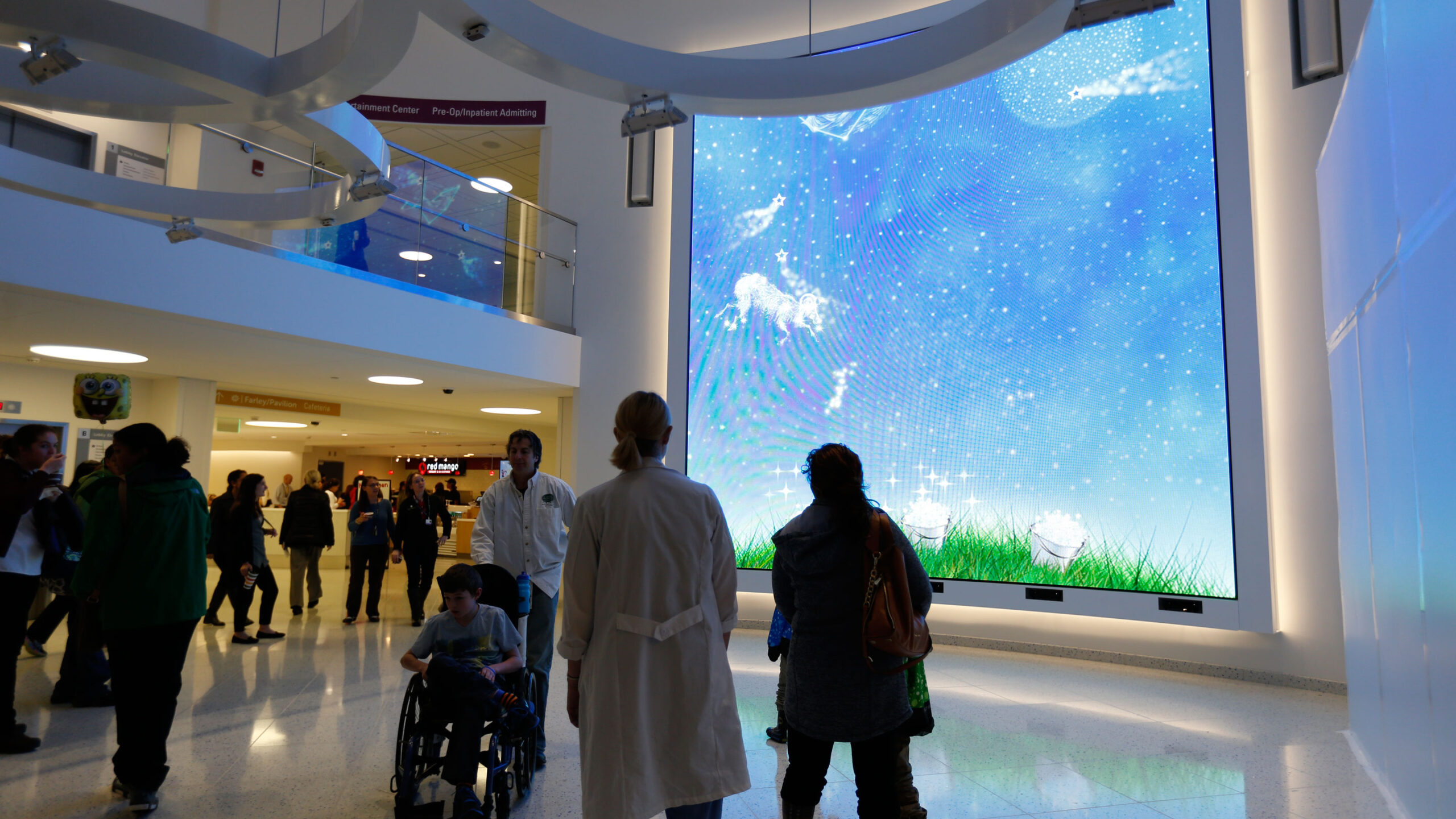
| Clients: | Boston Children’s Hospital |
| Location: | Boston, MA |
| Date: | Fall 2014 |
| Team: | UConn DMD |
| Role: | Project Manager, Student Designer |
| Tech: | Unity, Motion Capture, Kinect, LED Video Wall |
Empowering children is the focus of the Boston Children’s Hospital Interactive Media wall. This two-story tall LED screen invites and intrigues children and their families as they enter the hospital with characters and shapes playfully mirroring their movements.
Nine unique scenes and environments rotate throughout the day to ensure fresh impressions and new experiences. Utilizing thirteen Microsoft Kinect sensors, seven optical sensors, and sixteen computers, all tied together with custom code, the system observes and adapts to the positions and gestures of guests as they move throughout the atrium space to create a memorable experience.
The Prompt

Boston Children’s Hospital is a global leader in children’s health. As the focal point of the lobby the wall is one of the first experiences that families have upon entering the hospital, highlighting just how important it was for us to make this a positive and memorable experience.
We put a specific focus on designing an experience that would welcome the multitudes of ages, and cultures that come from around the world to this hospital.
Ultimately, this project’s goal was to create a positive experience for guests of all ages visiting the hospital, and to help inspire children to explore and engage with their environment making their visit as positive as possible.
The Process
Computers
This system has a significant amount of hardware behind the scenes in order to digest all the data and compile it into the full interaction. A total of sixteen computers pull in data from all the Kinect and optical sensors, process the data into a tracking array, and pass that data off to render within custom Unity applications.




Sensors
The overall system consists a total of 13 Microsoft Kinects. While we were developing the project, Microsoft released the Kinect V2 which featured a much higher image and skeletal tracking fidelity. As the Kinect for Windows V1 featured lower resolution we were able to send the signal more reliably over the long distance required for skeletal tracking in the back half of the play field. Finally, several optical webcam sensors tracked the positional data of guests in the space. All these sensors had the data pulled into the computers which parsed the data and simplified it to stream over the network to be compiled into the full tracking data set.



Wilbur Cross Prototype
Early on we constructed a prototype system locally within the Atrium of Wilbur Cross Library on the University of Connecticut’s campus. Being centrally located, and a popular study location, it worked well for our development as there was always a steady flow of people for system and user testing.
We replicated the layout of the sensors and display as close as we could to the final installation, however, the layout of the two spaces were very different. For one, the computers were significantly further away. This ended up being to our advantage as testing in this worst case scenario allowed us to identify failure points and bugs, and also focus on sensor signal consistency and reliability.
Another major difference was that this prototype featured a 20,000 Lumen Barco projector allowing us to test at scale for both a lower cost and allowing us to get up to speed more quickly. To compensate for the final installation in Boston displaying the images on an LED wall, we tested all images we created on a small scale test LED screen in our offices for color accuracy and clarity.
The Product

The Press
https://today.uconn.edu/2015/01/hospitals-high-tech-wall-opens-doors-to-imagination/
